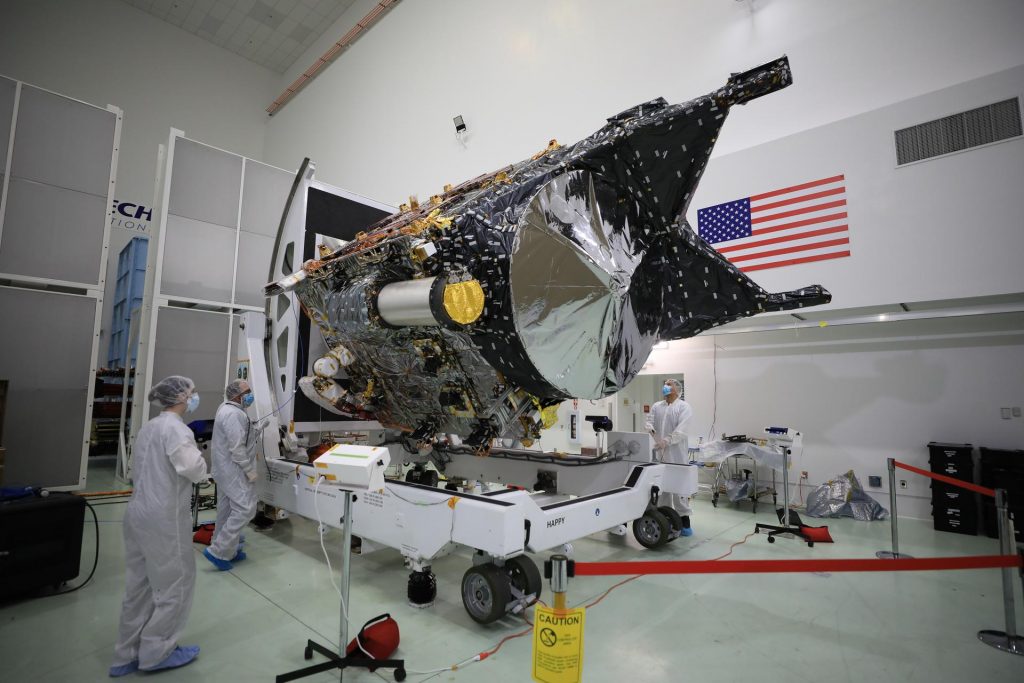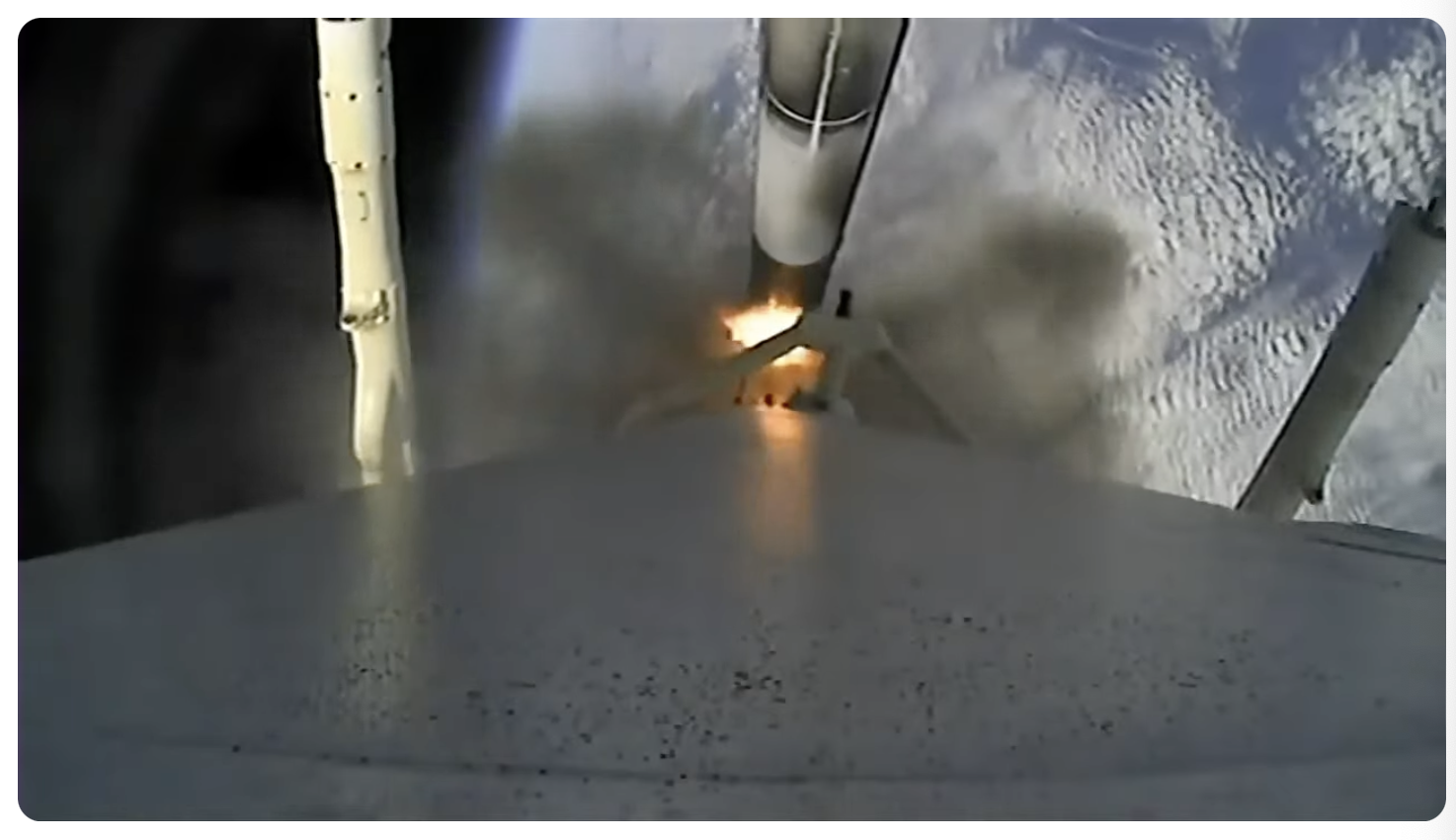
Rising atop a pillar of golden fire and 5.1 million pounds (2.3 million kilograms) of thrust, the fourth Falcon Heavy of 2023 took flight from historic Pad 39A at the Kennedy Space Center (KSC) in Florida at 10:19 a.m. EDT Friday, carrying NASA’s Psyche spacecraft on the first leg of a multi-year, 1.5-billion-mile (2.4-billion-kilometer) trek to explore a potato-shaped, metal-rich asteroid of the same name, which may yield clues to the Solar System’s evolution. Due to the high-energy demands of today’s mission, the Heavy’s brand-new B1079 center core was expanded, but the twin side-boosters (B1064 and B1065) returned to synchronized on-point touchdowns on solid ground at Landing Zones (LZ)-1 and 2 at Cape Canaveral Space Force Station, both wrapping up their fourth flights.
“Liftoff of Falcon Heavy and Psyche,” exulted the launch announcer, “on a mission to a metal asteroid in deep space to study the building blocks of our planet’s inner space.” The spectacular launch had been a long time coming, as outlined in AmericaSpace’s preview story. The 5,750-pound (2,600-kilogram) Psyche spacecraft will voyage beyond the orbit of Mars, picking up a boost from the red planet’s gravity three years hence, before rendezvous with asteroid Psyche—which circles the Sun as close as 234 million miles (378 million kilometers) and as far as 309 million miles (497 million kilometers)—in August 2029.

Photo Credit: Jeff Seibert/AmericaSpace
“Congratulations to the Psyche team on a successful launch, the first journey to a metal-rich asteroid,” said NASA Administrator Bill Nelson. “The Psyche mission could provide humanity with new information about planet formation while testing technology that can be used on future NASA missions. As Asteroid Autumn continues, so does NASA’s commitment to exploring the unknown and inspiring the world through discovery.”

It will spend at least 21 months circling the 140-mile-wide (220-kilometer) Psyche, which is predominantly composed of iron and nickel and constitutes one of the Solar System’s relatively few metal-rich asteroids. The 5,750-pound (2,600-kilogram) spacecraft will adopt a group of orbital “regimes” around Psyche of steadily decreasing altitudes, from “Orbit A” at 430 miles (700 kilometers) to “Orbit D” at just 53 miles (85 kilometers).
Those orbits will facilitate a range of observations of Psyche, including identification of magnetic-field signatures, preliminary topographical mapping, gravity-field measurements and analysis of surface chemical constituents. Long hypothesized to be the exposed core of a protoplanet—a theory now largely ruled out—Psyche is known from ground-based observations to possess a pair of enormous craters, some 56 miles (90 kilometers) wide, as well as a group of impact features near its south pole.

Psyche’s journey formally began in January 2017, when it was selected as NASA’s next Discovery Program mission, cost-capped at $450 million. Led by the Jet Propulsion Laboratory (JPL) in Pasadena, Calif., and Arizona State University (ASU) in Tempe, Ariz., and with Space Systems/Loral (SS/L)—now part of Maxar—of Palo Alto, Calif., as the mission’s industrial partner, Psyche was initially targeted for an October 2023 launch, but in May 2017 it was advanced a year to summer 2022, permitting an arrival at the asteroid in January 2026, four years sooner than originally intended.
As the spacecraft’s development progressed, in February of 2020 NASA awarded SpaceX a $117 million contract to loft Psyche aboard a Falcon Heavy booster during a 2.5-month “window” of launch opportunities between 1 August and 11 October 2022. However, following Psyche’s delivery to Florida in May 2022, NASA revealed that the mission would no longer meet its summer 2022 launch, due to issues pertaining to the late delivery of its flight software and test equipment.

Launch was realigned to occur during a three-week period from 5-25 October 2023, with Psyche encapsulated in its Falcon Heavy payload fairing and transported to Pad 39A late last month. A week-long delay to the 12th was called to allow teams to complete verifications of parameters needed to control Psyche’s nitrogen cold gas thrusters, with another 24-hour slip to Friday the 13th—unlucky for some, but not, it seems, Psyche—enforced by poor weather conditions along the Space Coast.
Friday’s weather was initially predicted to hover around 40-percent-favorable, thanks to the potential for showers and storms later in the day. “The late morning backup window looks to be before coverage increases,” noted the 45th Weather Squadron at Patrick Space Force Base in its L-1 update on Thursday, “but it will be unsettled enough that early activity can’t be ruled out along with anvils from any ongoing storms to the west.”

As circumstances transpired, the outlook markedly brightened to around 85-percent-favorable, as fears that the fabled misfortune of Friday the 13th might scupper the launch ultimately proved groundless. Fueled with over 2.8 million pounds (1.3 million kilograms) of rocket-grade kerosene (known as “RP-1”) and liquid oxygen, the Heavy was making the eighth outing of its career and its fourth launch of 2023.
Although the B1079 center core was embarking on its first (and only) flight, the two side-boosters had both flown on three prior Heavy missions in November of 2022 and more recently last January and July. Their past experience was clearly manifested in pre-launch images of the behemoth on the pad, with B1079 a glistening white and B1064 and B1065 blackened and scorched from their earlier high-energy flights and re-entries.

Notably, B1064 and B1065 will be used as side-boosters on the very next Heavy mission, possibly later this fall “or maybe early next year” to loft the U.S. Space Force’s highly classified USSF-52 payload. And they will pull added duty as side-boosters for another Heavy flight in October 2024 to deliver NASA’s Europa Clipper on a voyage to explore Jupiter’s ocean-bearing moon in unprecedented depth.
Two-and-a-half minutes into today’s flight, as planned, the side-boosters separated from the Heavy and both went on to execute a trio of engine “burns”—two entry burns and one landing burn apiece—before alighting on LZ-1 and LZ-2, only a few seconds apart, at just past eight minutes since launch. B1079 continued burning its own suite of nine Merlin 1D+ engines until four minutes after liftoff, then was discarded to pass the baton onto the single Merlin 1D+ Vacuum engine of the second stage.

The second stage was tasked with a pair of burns. A standard, six-minute firing was followed by a 45-minute period of “coasting”, then a shorter, 150-second burn, and deployment of Psyche at 62 minutes into the flight.
With Psyche off the ground, attention now returns to neighboring Space Launch Complex (SLC)-40 at Cape Canaveral Space Force Station, where a single-stick Falcon 9 booster stands ready with a payload of 22 Starlink low-orbiting internet communications satellites for liftoff later tonight. Originally scheduled to fly overnight last Sunday/Monday, launch was postponed due to high winds and then stood down indefinitely until after the high-priority Psyche mission was underway.

Shortly after today’s successful launch, SpaceX revealed that it is tracking six T-0 points from 7:01 p.m. EDT through 10:29 p.m. EDT Friday to get B1067 uphill. Another five opportunities are available between 6:36 p.m. EDT and 9:51 p.m. EDT tomorrow.
Weather for Friday’s second launch from Florida looks generally acceptable, ranging from 60 to 80 percent favorability. “The primary launch weather concerns Friday evening are lingering cumulus and thick cloud layers that should clear through the window,” noted the 45th Weather Squadron, adding that Saturday promises to be “significantly drier”, but tempered by the risk of violating the Liftoff Winds Rule.






Software has become the cornerstone of modern technological advancement, permeating every aspect of our lives. Its transformative power has reshaped industries, revolutionized communication, and propelled innovation to unprecedented heights. As we continue to push the boundaries of what’s possible, the evolution of software remains integral to shaping our future and solving complex challenges in the digital age
Digital marketing is an essential tool in the modern business world, offering a plethora of strategies to connect with an online audience. To succeed in this digital age, businesses must embrace and master these digital marketing techniques to remain competitive and relevant in the ever-changing online landscape. For more Services you can visit Our site https://smarttechnology.com.bd/